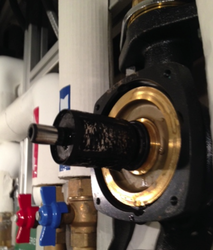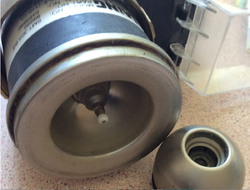I'm putting in a pellet boiler with oil backup with a 119 gallon buffer tank, zone pumps and boiler pumps pumping to return. Should I put in a strainer and if so, where should I put it? The oil boiler never had one and I don't want to unnecessarily add more friction loss.
Whether to Use a Strainer and Where to Put it?
- Thread starter velvetfoot
- Start date
-
Active since 1995, Hearth.com is THE place on the internet for free information and advice about wood stoves, pellet stoves and other energy saving equipment.
We strive to provide opinions, articles, discussions and history related to Hearth Products and in a more general sense, energy issues.
We promote the EFFICIENT, RESPONSIBLE, CLEAN and SAFE use of all fuels, whether renewable or fossil.
You are using an out of date browser. It may not display this or other websites correctly.
You should upgrade or use an alternative browser.
You should upgrade or use an alternative browser.
- Status
- Not open for further replies.
Coal Reaper
Minister of Fire
if your tank is really clean then you might not want to worry about it. mine were not so i put one at each location that water would be exiting the tanks so i didnt have any rust flakes or whatever getting caught elsewhere in the system. advise to put valves on each side of the strainer so that you do not have to depressurize/drain part of your system in order to clean the strainer out. for this reason i have yet to clean mine. 

maple1
Minister of Fire
Likely don't have to with the nice new clean stuff.
I put a Wye in my system, just upstream of the loading unit on the return line. Pretty easy to clean - just open a valve that is on the drain/screen side & let some stuff out into a drain tray. Also have isolation valves on each side in case I want to take the screen out. Having said that, the couple of times I have done that, I haven't found much, at all. That's with 2 used propane tanks just up stream of it. The main thing you could have an issue with is loose bits of stray solder, and maybe teflon tape, I'd say. They're not that expensive or hard to put in though, for a bit of peace of mind. The isolation valves on each side will likely cost way more than the strainer.
I put a Wye in my system, just upstream of the loading unit on the return line. Pretty easy to clean - just open a valve that is on the drain/screen side & let some stuff out into a drain tray. Also have isolation valves on each side in case I want to take the screen out. Having said that, the couple of times I have done that, I haven't found much, at all. That's with 2 used propane tanks just up stream of it. The main thing you could have an issue with is loose bits of stray solder, and maybe teflon tape, I'd say. They're not that expensive or hard to put in though, for a bit of peace of mind. The isolation valves on each side will likely cost way more than the strainer.
I just put a generic Y strainer on my Taco HSS model, in front of the thermostatic valve, and it bumped up the head requirement by one foot! I think I'm gonna pass. Do some good flushes.
alaskawild
New Member
velvetfoot...
Maybe you'd like to consider a Caleffi Dirtmag. I was skeptical but after installing a few I'm a believer. The secret is in the magnet! I had no idea at the amount of iron traveling in a system. The old wye strainers catch the bigger stuff but there is no way they can catch all the iron I've seen pulled out by the 2 Dirtmags I've installed. Amazing and low restriction!
Maybe you'd like to consider a Caleffi Dirtmag. I was skeptical but after installing a few I'm a believer. The secret is in the magnet! I had no idea at the amount of iron traveling in a system. The old wye strainers catch the bigger stuff but there is no way they can catch all the iron I've seen pulled out by the 2 Dirtmags I've installed. Amazing and low restriction!
Attachments
velvetfoot...
Maybe you'd like to consider a Caleffi Dirtmag. I was skeptical but after installing a few I'm a believer. The secret is in the magnet! I had no idea at the amount of iron traveling in a system. The old wye strainers catch the bigger stuff but there is no way they can catch all the iron I've seen pulled out by the 2 Dirtmags I've installed. Amazing and low restriction!
I would highly recommend a dirt separator with magnetic band if you plan on ECM circs, now or in the future. He is an ECN circ I disassembled after getting error codes on low RPM.
It was on a clean system, all pex, stainless steel boilers. The only steel and iron was the expansion tank and pump volutes.
A dirt separator holds the scrubbed dirt and magnetic particles out of the fluid stream.
a y strainer or cartridge type filter reduces flow from day one, and unless it is cleaned or checked it will cause a flow restriction.
Attachments
alaskawild
New Member
Yep like I said I'm a believer!I would highly recommend a dirt separator with magnetic band if you plan on ECM circs, now or in the future. He is an ECN circ I disassembled after getting error codes on low RPM.
It was on a clean system, all pex, stainless steel boilers. The only steel and iron was the expansion tank and pump volutes.
A dirt separator holds the scrubbed dirt and magnetic particles out of the fluid stream.
a y strainer or cartridge type filter reduces flow from day one, and unless it is cleaned or checked it will cause a flow restriction.
You guys are killing me with these doo dads and gee gaws. Ok, I'll order it-bear in mind the manifold is 1.25" . Seriously, thanks for the tip. The buffer tank looked like it was bleeding out the drain when I tipped it off its pallet. And it has 4 ECM circs. Not sure exactly where I'll put it. The instructions say on the return before the boiler, but I have two boilers and the manifolds after the two join are crowded.
I installed a hot water filter on the input side from storage to the plate hx. Initial install trapped lots of stuff, but after about 6 filter changes there is nothing that the filter is catching any longer.
Do the ECM pumps attract iron because of the magnets? Where are those magnets, anyway? They can be cleaned, right?
A blurb from B&G says this about the Vario:
"Simplicity
the only moving part is the rotor/impeller unit. the
shaft, shaft seals and conventional bearing bushings
have been eliminated. the rotor/impeller has
anti-block technology.
the anti-block technology separates the main fl ow of
the pumped media completely from the permanent
magnetic parts. it is virtually impossible for the ecocirc
auto or vario to block-up even in an old open system."
I found room after all, but the combo of zone and boiler circs plus the buffer tank make it more complicated, for me anyway, although anywhere would help, I'm sure.
I think I will put it on the return manifold, between the buffer tank and the boiler pumps. That way, I could run that a while without getting the zone circs involved.
A blurb from B&G says this about the Vario:
"Simplicity
the only moving part is the rotor/impeller unit. the
shaft, shaft seals and conventional bearing bushings
have been eliminated. the rotor/impeller has
anti-block technology.
the anti-block technology separates the main fl ow of
the pumped media completely from the permanent
magnetic parts. it is virtually impossible for the ecocirc
auto or vario to block-up even in an old open system."
I found room after all, but the combo of zone and boiler circs plus the buffer tank make it more complicated, for me anyway, although anywhere would help, I'm sure.
I think I will put it on the return manifold, between the buffer tank and the boiler pumps. That way, I could run that a while without getting the zone circs involved.
Do the ECM pumps attract iron because of the magnets? Where are those magnets, anyway? They can be cleaned, right?
A blurb from B&G says this about the Vario:
"Simplicity
the only moving part is the rotor/impeller unit. the
shaft, shaft seals and conventional bearing bushings
have been eliminated. the rotor/impeller has
anti-block technology.
the anti-block technology separates the main fl ow of
the pumped media completely from the permanent
magnetic parts. it is virtually impossible for the ecocirc
auto or vario to block-up even in an old open system."
I found room after all, but the combo of zone and boiler circs plus the buffer tank make it more complicated, for me anyway, although anywhere would help, I'm sure.
I think I will put it on the return manifold, between the buffer tank and the boiler pumps. That way, I could run that a while without getting the zone circs involved.
ECM motors use permanent magnets, so a strong magnetic field is always present. The bearings on most wet rotor circs are lubed by the fluid. So whatever fine particles that are in the fluid, can work it's way into the bearing and the small space between the rotor and rotor can.
True the B&G/ Laing uses a different type of drive, The impeller spins on a ceramic ball end on the shaft. Dirt and grit gets between that ball and the socket it rides in in the impeller. After time the bearing ball end wears away. So it will either seize up, or vibrate like crazy.
If you have a rotating part, somewhere you have a bearing.
A separator or filter just protects the important and expensive components in the system, it's cheap insurance. You wouldn't run your truck without an air and oil filter, would you?
Attachments
I seem to remember a magnetic force when I took apart the Vario to take a look. Here is the impeller:

- Status
- Not open for further replies.
Similar threads
- Replies
- 9
- Views
- 3K
- Replies
- 8
- Views
- 994
- Replies
- 0
- Views
- 1K
- Replies
- 3
- Views
- 3K



